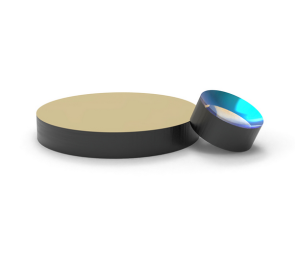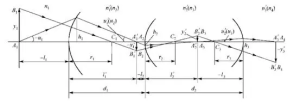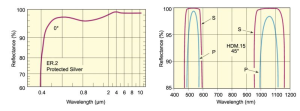Most materials will absorb electromagnetic radiation with wavelengths ranging from 0.8 µ m to 14 µ m in the infrared spectral region, which are characteristic of the molecular structure of materials. Infrared absorption spectroscopy is a common chemical analysis tool, which is used to measure the absorption of infrared beams that have passed through the sample. The position of the absorption peak in the infrared spectrum is the characteristic of the chemical composition or purity of the sample, and the intensity of the absorption peak is in direct proportion to the concentration of the substance characterized by the peak.
Infrared spectroscopy can be used for qualitative and quantitative nondestructive analysis of gases, liquids, pastes, powders, films and surfaces. The molecular absorption spectrum provides a unique absorbance “fingerprint”, which can be used to infer the chemical composition and species concentration of the sample. Figure 1 shows the infrared absorption spectra of some gases routinely measured in stack emission monitoring applications. It can be seen that each labeled gas type shows a unique IR absorption mode.
The infrared spectrometer is usually composed of broadband infrared light source, wavelength separation device and detector, as shown in Figure 2. Liquid or gas samples are usually contained in the sample cell. The absorption spectroscopy or reflection spectroscopy can be used to analyze the solid samples in situ or in the support measurement system, or the powder samples can be pressed into discs, diluted with IR transparent materials or diluted into a paste, usually called a paste.
Infrared spectrometer
Popular infrared spectrometers for conventional chemical identification and quantitative measurement include grating based/dispersive IR spectrometers, FTIR spectrometers, and filter based or non dispersive IR (NDIR) instruments. The selection of spectrometers for specific applications is driven by requirements such as sensitivity, matrix complexity, packaging and cost requirements.
Dispersion or grating spectrometer
Dispersion spectrometers use gratings to disperse and separate the wavelengths of broadband light. There are two types of dispersion spectrometers: monochromators and spectrometers. The former uses a single piece photodetector and a rotary grating assembly, while the latter uses a fixed grating assembly and a photodetector array. The advantage of the dispersive spectrometer is that it is simple and easy to use, can realize hardware miniaturization, and retain the ability to scan a relatively wide spectral range. However, compared with FTIR or NDIR instruments, throughput (or optical expansion) is limited because only a small part of the source light eventually falls on the photodetector. Therefore, dispersive spectrometers are usually used in VIS and NIR spectral regions, rather than in MIR regions with low photon energy.
FTIR spectrometer
The FTIR spectrometer uses interference to modulate IR radiation in the time domain to generate spectra to generate interferograms, and then Fourier transform them. In Michelson interferometer commonly used in FTIR, beam splitter (partial reflector) is used to divide the incident beam into two identical beams. Each of these beams goes through a different path and is recombined before reaching the detector. Path difference, that is, the difference in the distance each beam travels, will create a phase difference between them. The recombined beam is an interferogram, that is, a modulated signal as a function of path difference. Fourier transform of the interferogram produces the spectrum of the incident beam.
FTIR spectrometer has many advantages over traditional dispersive spectrometer. First, it can be quickly measured in a wide wavelength range. MKS MultiGas ™ Modern FTIR instruments such as FTIR analyzer can complete scanning in 200 milliseconds. Each scan will cover the entire MIR wavelength range from about 2 µ m to 16 µ m, depending on the material of the optics and the type of photodetector used in the instrument. Secondly, perhaps an important fact is that FTIR spectrometers have high luminous flux or optical spread. FTIR does not use slits to control the wavelength resolution of the instrument. As a result, under the same conditions, the spectrum generated by FTIR spectrometer is usually “steeper” than that generated by dispersion spectrometer. This is important in quantitative analysis, where SNR usually determines the measurement sensitivity. Another advantage of FTIR spectrometer is its wavelength accuracy and stability. FTIR spectrometers usually use lasers to control the position and speed of the moving mirror, and trigger the collection of data points during the entire scanning process. Well designed FTIR instruments provide very high inter cell repeatability without the need for cumbersome and expensive single cell calibration.
Non dispersive infrared (NDIR) analyzer
NDIR analyzer is a filter based instrument designed for specific measurement applications. For example, NDIR analyzer is an industry standard method for measuring CO and CO2 concentration in stack emission monitoring. NDIR instruments usually do not capture wavelengths and generate spectra, but capture the absorption of discrete wavelengths related to the chemical substance being tested. They are realized by using optical filters that transmit light in a selected narrow band region.
Filters used in NDIR instruments are usually interferometric, called “etalon”, which is essentially a Fabry Perot interferometer. It is usually made of a thin film gasket that separates two thin film reflectors. Wave interference will be generated in the etalon, and waves in the same phase will interfere with each other and transmit through the filter. The remaining waves have cancelling interference and are therefore “blocked”. Broadband infrared sources are usually blackbody radiation generated by heated filaments, such as tungsten or Kanthal.
The main advantage of NDIR instrument is its simple hardware. This makes NDIR instruments both low-cost and durable, making them very suitable for industrial applications. MKS Process Sense ™ It is an example of NDIR analyzer used in semiconductor process applications.
Tunable filter spectrometer (TFS ™)
TFS ™ Spectrometer refers to MKS NDIR instrument that provides wavelength scanning function. Wavelength scanning is usually achieved by adjusting the gap distance between two thin film reflectors in the Fabry Perot element. TFS of MKS ™ The spectrometer adjusts the incident angle of light by rotating the filter, so as to adjust the gap distance. With the adjustment of the incident angle, the transmission wavelength of the filter will also change. With the increase of the incident angle, the transmission scanning reaches a lower wavelength.
Infrared spectrum application using MKS products
MKS Instruments provides several analytical tools for emission and process monitoring applications based on infrared spectroscopy.
2. Emission monitoring
Gas emission monitoring is usually required at emission sources such as power plant chimneys and chemical manufacturing facilities. Accurate monitoring data is an important part of compliance and environmental protection plans, which aims to control and regulate pollutants in the air, such as carbon monoxide, nitrogen oxides, sulfur dioxide and ozone, and greenhouse gases, such as methane and carbon dioxide. MultiGas of MKS ™ The 2030 system is a high-speed, high-resolution gas analyzer based on FTIR, which aims to simultaneously monitor more than 30 kinds of exhaust gases in one second.
3. Chemical reagent and toxic industrial chemical detection
In the safety industry, the demand for rapid and reliable detection of chemical reagents and toxic industrial chemicals is growing. FTIR based AIRGARD of MKS Instruments ® The system can detect the one billionth (ppb) content of most chemical warfare agents (CWA) and toxic industrial compounds in 20 seconds. It is an industry standard and a fixed monitoring of CWA in key infrastructure buildings.
4. Semiconductor process monitoring
The chamber of semiconductor chemical vapor deposition process must be cleaned regularly to remove the deposits deposited on the chamber wall and internal components. The appropriate cleaning time for different processes depends on the complex relationship between variables, such as the thickness of deposits, the internal temperature of the chamber components, the deposition/sputtering ratio, and the chemical composition of the material to be removed. MKS Process Sense ™ The endpoint sensor uses NDIR method to monitor the wastewater in the cleaning process of the treatment room in real time. For example, Process Sense ™ The monitor is used in conjunction with the fluorine based chamber cleaning process to monitor silicon tetrafluoride (SiF4) as a by-product from the chamber for the silicon based deposition process (including polysilicon, silicon dioxide, and silicon nitride). The sensor reports the residual SiF4 content in the chamber effluent in real time, so that the user can quickly detect the end point of the cleaning process and avoid excessive etching of the chamber components, which may lead to damage or other maintenance problems.
5. Calorific value measurement of hydrocarbon gas
The calorific value (BTU content) data of fuel is an important parameter for optimizing the control process, such as power generation, petrochemical manufacturing and flare control. Traditionally, gas chromatography (GC) is an analytical technique commonly used to determine the calorific value of fuels. However, GC analysis is very slow (it takes several minutes to update), and GC instruments usually require a lot of maintenance. MKS’s Precise ® The gas analyzer is the first all optical analyzer in the industry to conduct quantitative analysis of hydrocarbon gas. Precisive analyzer adopts TFS obtained ™ The analyzer technology is a simple and robust NDIR instrument, which can provide high-precision BTU measurement in the often dirty and dangerous industrial environment.



